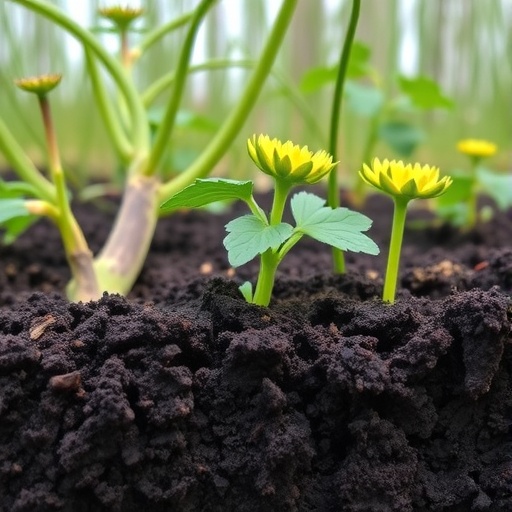Soil contamination with organic pollutants has emerged as a profound challenge threatening global food security and environmental health. According to recent data, nearly 80 percent of agricultural soils worldwide are burdened with residues from pesticides, pharmaceuticals, industrial chemicals, and persistent organic pollutants. These contaminants not only diminish soil fertility but also pose significant risks to human health via crop uptake and ecosystem disruption. Confronting these multifaceted issues demands innovative, sustainable remediation strategies that harmonize ecological restoration with economic viability.
A groundbreaking review published in the journal Biochar shines a spotlight on an advanced, nature-inspired solution that synergistically leverages biochar and rhizoremediation. Rhizoremediation, a process that employs the symbiotic relationship between plant roots and their associated microbial communities, facilitates the natural breakdown of soil pollutants. The integration of biochar—a carbon-rich, porous, and engineered material derived from biomass—magnifies the remediation potential of this biological process, offering a dual mechanism for soil detoxification and ecosystem resilience.
Biochar’s role extends far beyond a passive adsorbent. Its intricate porous architecture and chemically active surfaces provide an ideal microhabitat that nurtures microbial proliferation and diversity. Enhanced microbial colonization on biochar surfaces can dramatically improve degradation enzymatic activity against a broad spectrum of organic contaminants, including crude oil derivatives, polycyclic aromatic hydrocarbons (PAHs), antibiotic residues, and plastic polymers. By modifying the physicochemical properties of the rhizosphere, biochar raises the bioavailability of these pollutants, making them more accessible for microbial metabolism and eventual mineralization.
The review underscores that biochar addition to contaminated soils does not merely immobilize toxins; it orchestrates a thriving microbial ecosystem that accelerates pollutant catabolism. This biochar-microbe synergy enhances the efficiency of rhizoremediation, which capitalizes on root exudates and microbial enzyme systems to dismantle complex organic molecules into inert or less harmful byproducts. Consequently, biochar-enhanced rhizoremediation not only cleanses soils but simultaneously fosters plant growth by improving soil texture, nutrient retention, and water holding capacity.
A notable advancement addressed in the study is the concept of “bioengineering” biochar to tailor its surface chemistry and porosity for targeted remediation outcomes. Through controlled pyrolysis parameters and chemical activation, scientists can engineer biochar variants that selectively adsorb or catalyze the degradation of specific contaminants. This precision design opens new avenues for customized soil remediation solutions, particularly when combined with meta-omics technologies such as metagenomics and metabolomics. These analytical tools enable researchers to decode the complex microbial consortia thriving within biochar-amended rhizospheres, elucidating functional genes and metabolic pathways pivotal to pollutant degradation.
This mechanistic insight facilitates the rational development of biochar formulations optimized for distinct soil types and contamination profiles, enhancing remediation predictability and scalability. The coupling of biochar engineering and microbial ecology represents a frontier in environmental biotechnology, promoting sustainable soil management practices capable of addressing diverse pollution scenarios.
Beyond the environmental imperative, the burgeoning biochar industry epitomizes the intersection of ecological restoration and circular economy principles. Valued at approximately 2.05 billion USD in 2023, the biochar market is projected to nearly double by 2032, driven by its expanding applications in agriculture, waste management, and environmental rehabilitation. This economic trajectory highlights biochar’s potential to not only remediate soils but also generate income streams from agricultural residues and organic waste conversion, thereby supporting rural livelihoods and regional bioeconomies.
Importantly, biochar-assisted rhizoremediation aligns with global climate mitigation strategies. Biochar’s stable carbon structure serves as an effective carbon sink, sequestering atmospheric CO2 for centuries when incorporated into soils. This carbon storage capability augments the environmental benefits of remediation, simultaneously addressing soil health degradation and greenhouse gas reduction. Furthermore, by restoring soil biodiversity and function, this approach underpins ecosystem resilience and agricultural sustainability in the face of escalating anthropogenic pressures.
Researchers Nandita Das and Piyush Pandey, leading voices in soil remediation science, emphasize that this innovative approach transcends conventional pollution abatement. “Biochar-driven rhizoremediation does not just clean contaminated soils; it orchestrates ecosystem healing by fostering the intricate biological networks essential for sustainable land management,” remarked Das. Their review delineates a compelling vision where pollution control, agricultural productivity, and environmental stewardship converge through biochar-mediated interventions.
The operational scalability and cost-effectiveness of biochar-enriched rhizoremediation further reinforce its appeal for widespread adoption. Unlike chemical or physical remediation methods, which are often expensive and environmentally intrusive, biochar application is relatively low-cost and adaptable to diverse geographies and socio-economic contexts. The versatility of feedstock sources for biochar production—from agricultural residues to municipal organic waste—supports circular bioeconomy frameworks that valorize waste while regenerating degraded ecosystems.
In light of mounting soil contamination challenges, the convergence of microbial ecology, biochar engineering, and advanced omics analytics heralds a transformative paradigm in environmental remediation. This amalgamation fosters resilient, self-sustaining soil systems capable of enduring pollution stress, enhancing nutrient cycling, and supporting robust plant growth. As global agricultural landscapes strive to balance productivity with environmental integrity, biochar-driven rhizoremediation presents a scalable, scientifically grounded, and economically viable path forward.
Ultimately, this strategy embodies the ethos of ecosystem-based management, recognizing soil as a living matrix whose health is paramount to planetary well-being. As scientific understanding deepens, and technological innovations mature, biochar-assisted rhizoremediation is poised to play a pivotal role in restoring the vitality of contaminated soils worldwide—ushering in an era where human ingenuity and natural processes collaboratively heal the planet.
Subject of Research:
Not applicable
Article Title:
Biochar-driven rhizoremediation of soil contaminated with organic pollutants: engineered solutions, microbiome enrichment, and bioeconomic benefits for ecosystem restoration
News Publication Date:
28-Aug-2025
Web References:
https://link.springer.com/journal/42773
References:
Das, N., Pandey, P. Biochar-driven rhizoremediation of soil contaminated with organic pollutants: engineered solutions, microbiome enrichment, and bioeconomic benefits for ecosystem restoration. Biochar 7, 101 (2025). DOI: 10.1007/s42773-025-00491-x
Image Credits:
Nandita Das & Piyush Pandey
Keywords:
Bioremediation, Environmental engineering, Environmental sciences, Soil chemistry




